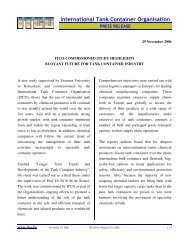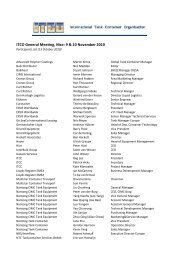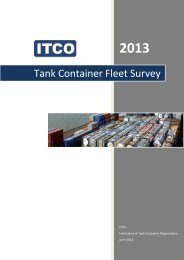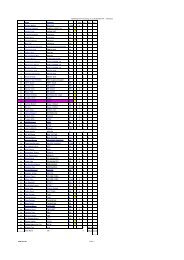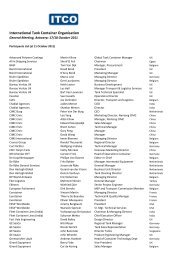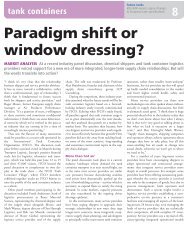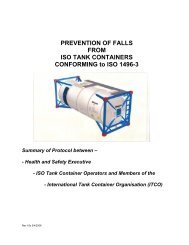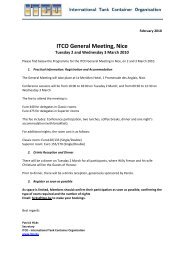You also want an ePaper? Increase the reach of your titles
YUMPU automatically turns print PDFs into web optimized ePapers that Google loves.
ICHCA International <strong>Safe</strong>ty Panel Briefing Pamphlet No 30<br />
5.5.6 Non-mandatory Fittings on T50 <strong>Tank</strong>s<br />
5.5.6.1 Some T50 tank containers may be fitted with devices for measuring filling<br />
levels. Often these will be fitted in a recess similar to that described in<br />
section 5.3.6 in the rear end <strong>of</strong> the shell.<br />
5.5.7 <strong>Tank</strong> fittings must only be operated by a suitably qualified technician<br />
or operator who has in their possession the full details <strong>of</strong>:<br />
the load status <strong>of</strong> the tank<br />
the cargo<br />
whether the tank is under pressure or not<br />
5.6 Fittings on T75 Deeply Refrigerated Liquefied Gas <strong>Tank</strong>s<br />
5.6.1 Liquid and Vapour Load / Discharge Assemblies<br />
5.6.1.1 The loading and discharging assemblies on tanks intended for the transport<br />
<strong>of</strong> T75 deeply refrigerated liquefied gases are, by far, the most complex.<br />
Any number <strong>of</strong> valves and pieces <strong>of</strong> pipework that are usually found along<br />
one side <strong>of</strong> these tank containers may be found within one or more<br />
compartments. For each compartment there will be a connection for the<br />
liquefied gas to enter or leave the tank as well as for the vapour. These will<br />
have three closures as with the tanks for liquids and pressure liquefied<br />
gases. However they will be very different to the three closures on the<br />
other kinds <strong>of</strong> tank. This is due to the nature <strong>of</strong> the substances carried and<br />
the design <strong>of</strong> the tanks which, as noted above in paragraph 4.4.2, usually<br />
have a steel outer vacuum jacket surrounding the actual shell. In place <strong>of</strong><br />
the foot valve fitted to liquid tanks, there are usually two external valves. The<br />
inner valve is usually pneumatically operated. It requires a source <strong>of</strong><br />
pressure to be attached to it to open and hold it open.<br />
5.6.2 Controls for Filling Levels<br />
5.6.2.1 Additional valves may be fitted to control filling levels. It is commonplace for<br />
these tanks to be fitted with internal vertical pipes rising from the floor nearly<br />
to the top. Each one will be marked with the name <strong>of</strong> the gas for which it<br />
gives the maximum filling level. Once the shell has been filled to the<br />
required mass, for example so as not to exceed the maximum permitted<br />
weight <strong>of</strong> its CSC approval, liquefied gas overflows. There will be valves and<br />
associated pipework to control this process<br />
5.6.2.2 These tanks are also usually fitted with flow gauges, usually circular, by<br />
which the filling level may be determined.<br />
5.6.3 Pressure Raising Coils<br />
5.6.3.1 Some <strong>of</strong> these tank containers can self-discharge. This is achieved by<br />
diverting some <strong>of</strong> the liquefied gas into a pressure raising coil to turn it into<br />
gas and thereby raising pressure. This source <strong>of</strong> pressure is piped to the<br />
top <strong>of</strong> the shell to push out the remaining liquefied gas. <strong>Tank</strong>s containers<br />
with this possibility usually have a visible pressure coil, perhaps underneath<br />
or on the opposite side to the valve compartments.<br />
5.6.4 Cryogenic Pumps<br />
5.6.4.1 Some <strong>of</strong> these tank containers will be fitted with their own pumps located in<br />
the compartments on the side. These pumps have to be cooled down to<br />
the temperature <strong>of</strong> the liquefied gas inside the shell before they can be<br />
used. There will be associated pipework and valves on such tanks for the<br />
Page 19 ©ICHCA International Limited



